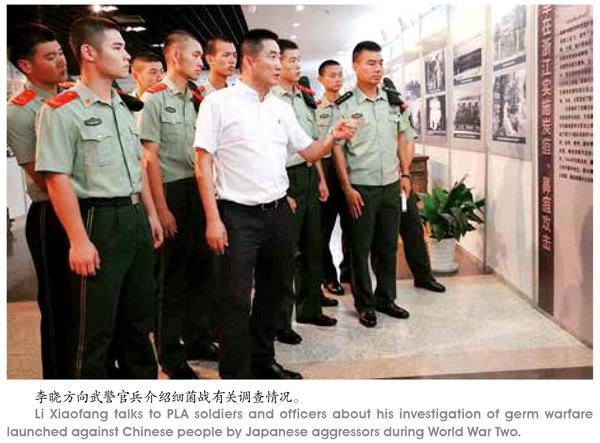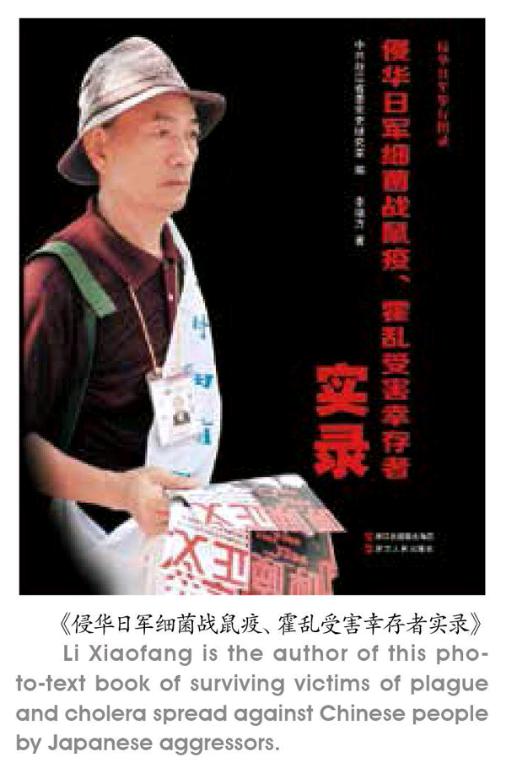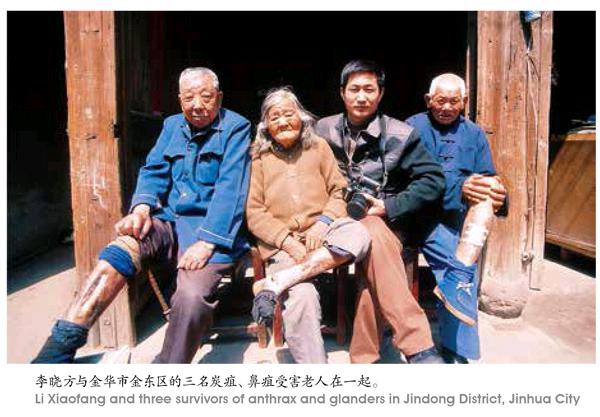李晓方:用镜头揭露骇人史实
2018-03-09徐继宏
徐继宏
很早就想写李晓方和他所做的事情,只是这样的话题太过于沉重,迟迟没有动笔。2017年12月的一天,笔者与他相约西子湖畔的寓所,展开了关于70多年前那场惨绝人寰战争的对话。
铁证如山揭罪行

“对于多数中国人,日军侵华战争中进行的细菌战只是一个遥远的概念。那是残忍的、苦难的,但业已终结的历史。没有人想到,在经历了感染后,有两种细菌的感染者,居然一直活了下来。”在李晓方的工作间,我一边翻看着《泣血控诉——侵华日军细菌战炭疽、鼻疽受害幸存者实录》,一边听李晓方讲他的调查故事。
李晓方,上世纪70年代生于安徽,后参军当卫生员,提干后成了专职新闻摄影干事。1995年的一天,他偶然地看到,一位退伍在媒体工作的战友,拍摄的细菌战幸存者一家人的照片:母亲感染了日军撒下的细菌,3个孩子受间接感染。历尽艰辛,但终究没有留住每个人的生命。
李晓方震撼了。后来他知道他的部队所在地曾经遭受过日军的侵略和洗掠。“新闻人”的职业敏感让他多长了一个心眼,只要一有时间,他就挂上相机到部队附近的村庄里转悠,和村民聊天,打听当年的情况。
“一天,我碰到一位70多岁的老大爷。聊着聊着,大爷拉起裤腿,指着腿上留下的一大块黑黑的疤痕对我说,‘日本佬当时不仅撒了鼠疫、霍乱,肯定还撒了其他细菌。我这腿,就是日本军撤退后不久烂的。当年十里八村烂腿、烂手、烂脸的人可多了,很多人很快就死了,没死的一辈子都在烂。”

李晓方想,这是种什么细菌?怎么会一辈子都好不了?“我要把这段历史用镜头记录下来……”从此,一发而不可收。他开始搜寻与细菌战有关的书籍、档案和史料。
通过研究,李晓方发现,凡是烂腿、烂脚的老人,大多在70岁上下,发病时间集中在1942年7月至9月间,此前当地没有人得过这种病,此后也没有。根据当年侵华日军731部队被俘者的口供,日军的细菌部队的确大量生产过炭疽杆菌,并在浙赣铁路沿线使用过。李晓方由此得出结论:老人们的烂腿、烂脚是因为炭疽杆菌感染。
2002年,美国历史学家哈里斯、医学家麦克·法兰兹布劳和马丁·法曼斯基专程赶到金华等地,对“烂腿村”进行了调查。调查结论与李晓方一致。
“一定要把这段鲜为人知的反人类丑恶历史公之于世!”2002年5月,李晓方连借带凑了4万多元,购置了一套高级相机,开始了他的记录工程。
2002年10月,李晓方来到金华市婺城区白龙桥镇下杨村寻访。他被村民引到了村里最破的一间房子前。一推门,一股臭气扑面而来,苍蝇嗡嗡乱转。在昏暗的灯光下,一位头发蓬乱的老人,正抱着自己的腿在呻吟,腐肉和血水一滴滴地掉在地上。老人名叫华庆云。20岁时和父亲上山砍柴,回来后兩人开始烂腿。5年后,父亲死了,华庆云丧失了劳动能力,靠母亲照料。母亲去世后,他靠着村里低保生活。就在李晓方找到他的一周前,他烂了60年的右腿突然从膝盖下断掉了。
李晓方问老人那段断腿呢?老人答:早扔到茅厕里去了。一个星期后,华庆云老人也离开了人世。

“我在和时间赛跑。”李晓方说,后来他每到一个村子调查,都会有人跟他说:“小伙子,你来晚了。他们大多数都死了。”
“并不是所有人都愿意接受采访和拍摄。”李晓方说,大多数幸存者以自己的遭遇为耻辱,将记忆和痛苦一起埋藏在过去。江山市大陈乡池茶村李妹头从15岁开始烂腿,送走了大多数同病相怜的村民。后来,她在镇上做小吃生意,以养活年幼的孩子。怕别人知道她的病后嫌弃她,她一年四季都穿着厚厚的袜子,从不敢告诉别人,也不敢去医院。李晓方找到她时,她和家人开始都不同意采访拍照,怕影响了生意。后来在李晓方的反复劝说下,李妹头瞒着家人,偷偷跑出来,让李晓方拍了,作了笔录。
在衢州市龙游县湖镇上溪头村,一位叫杨春莲的炭疽烂脚老人,深受病痛折磨。为了不让家人为自己的病腿背上负担,自己结束了生命。这一桩桩惨不忍睹的案例,让李晓方更加坚定了自己的选择。
据不完全统计,李晓方用了10年时间,跑了浙赣铁路沿线800多个村庄,寻访到240多位当年炭疽、鼻疽的幸存者。当李晓方将他们的悲惨经历汇编成《泣血控诉——侵华日军细菌战炭疽、鼻疽受害幸存者实录》一书正式出版时,240多位幸存者中又有三分之一离开了人世。
血泪如注控日寇
2005年,当李晓方闻听上海师范大学中国慰安妇问题研究中心主任苏智良披露尚有最后35名慰安妇活在人世的讯息后,当即选择在当年脱下穿了17年的军装,开始自费深入调查二战时期日军实施的慰安妇制度的罪行。
他先后到过中国的北京、黑龙江、山西、南京、上海、浙江、武汉、海南等地及韩国寻访到70余位幸存慰安妇。2016年12月11日,由李晓方编写的大型图片史料实录《世纪呐喊——67位幸存慰安妇实录》在南京首次发行,有15位来自山西沁县、武乡县的慰安妇是首次公开身份。
一张张图片、一件件实物、一个个风烛残年的老人。
调查也历经千难万险。李晓方说,首先想找到这些老人就很难。她们或居住于边远地区,或隐没于城市人海之中。一些偏远的地区,没有公交车,只通摩托,或是牛车、驴车。劳顿、辛苦不说,也很危险。还有,一些老人,尤其是新“发现”的慰安妇,就算找到了,也不愿轻易开口。有的事先联系好了,愿意说,但急急忙忙、不远千里赶到那里,老人又改了主意,不想说了。endprint
“回忆那段曾经的惨痛经历,对这些老人来说是一种痛苦,也是一种折磨。”李晓方说:“2007年冬天,我从媒体上看到南京有一位慰安妇‘证人雷桂英勇敢地站了出来,就立即赶往南京,见到了雷桂英。此后不到半年,这位‘活证人就离开了人世。”
在雷桂英老人离世后不久,家住江苏如皋市白蒲镇杨家园的90岁老人周粉英,在家人的一再鼓励下,终于愿意公开自己屈辱的慰安妇经历。2007年6月,李晓方见到了这位双目失明的老人。

“在调查中,我感受最深、最痛苦的是要在这些受害老人永远无法愈合的精神伤口上再‘揭疤。只要谈起那段经历,老人们大都泣不成声。有位受害老人的女儿在我调查寻访结束后对我说,老人在此后的一个月里都会睡不着觉,在被重新勾起的痛苦回忆中备受煎熬。这时,我的心里更加难受,心里非常矛盾和自责,不想再打扰她们。但每每想到侵华日军对亚洲40万妇女的摧残,看到日本政府一直在掩盖、抵赖这段罪恶历史时,我又禁不住怒火中烧,不能让侵略者掩盖那弥天大罪,要让世人都知道人类历史上这黑暗的一页。”李晓方说。
在当日的首发式上,来自山西沁县的老人李金鱼乘了20多个小时火车赶到南京,在这里,她第一次向媒体公开自己慰安妇的身份。
这位眼窝深陷、手如枯枝的老人面对众多相机和摄像机镜头哭诉“一生都给日本人毁了”。1944年,她刚满14岁,在农历二月的一天早晨,她和堂姐李金娥正在玩耍,突然被破门而入的日本兵抓到山西漳源镇交口村南山顶的炮楼里,被强占为日军慰安妇,受监禁两个月,受尽折磨。
尽管后来被父亲用很多钱还有鸡蛋、小米赎回了家,但李金鱼的命运就此改变。父亲去世后,为了还债,她被卖给了邻村一个比她大20岁的瞎眼男人做老婆。李金鱼一直不能生小孩,下腹经常疼。后来,医生从她的肚子里取出了大块的黑血块。经过长时间医治,李金鱼生了个儿子,但儿子在42岁就去世了,丈夫在26年前也走了。李金鱼现在一无所有,靠捡破烂为生。
李晓方说,他寻访的70多位老人中,很多是以拾荒、捡破烂为生的,没有经济来源,生活穷困潦倒,依赖民间资助生活,但这种资助并不固定。时至今日,在国内公开身份的还健在的慰安妇总数不到60人。
史料如镜警后人
李晓方不仅用镜头记录历史,揭露日军的駭人行径,他还在不断思考如何用历经20年的调查、搜集整理的这些活生生的案例、口述资料、图片影像、实物书证等,告诫后人不能忘记屈辱。
李晓方自费建立了中国首个专门发布侵华日军各种暴行受害者的网上陈列馆——《抗战受害者网上陈列馆》(网址:www.ww2china.com)。网站上陈列了他调查的千余名侵华日军实施的慰安妇、细菌战、南京大屠杀、重庆大轰炸、掳日劳工、遗留化学武器等各种反人类罪行受害者的图片、视频、手印及受害者本人的物品,供人们浏览和纪念。
同时,为了救助被疾病和贫困所困扰的受害者,给予这些年事已高的受害者人文关怀,李晓方四处筹款甚至贷款,并在热心公益企业的赞助下,专门成立了为侵华日军暴行受害幸存的困难老人提供生活救助、医疗救助、生活照料及精神抚慰的纯公益组织——“浙江夕阳红困难老人救助服务中心”。
李晓方说,他搜集了300多名受难者的各类物品近两千件,记录了他们生活的记忆点滴,希望能够建立一所受难幸存者纪念馆,让口述历史与实物有栖息之地,共同为后人叙述70多年前发生的那场战争,以及战争对他们一生的影响。
“不是为了记住仇恨,而是为了真实地记录那段历史,呼吁世人珍惜和平。”李晓方用正义和良知,记录历史,还原真相。他说,调查取证,永远在路上。
如今,他依然在多方奔走,记录历史,搜集史料,建立纪念馆……
李晓方说,当下,他最大的心愿就是“受难幸存者纪念馆”能够早日建成。
I had long since wanted to write about Li Xiaofang and his historical photos, but the topic seemed too horrible. Ultimately, I sat down with him at his home in Hangzhou on a December day last year and talked about the war of horror about 80 years ago and its victims and survivors.
“For most Chinese people, the germ warfare staged in China by Japanese aggressors is a remote and tiny fact in the books about the atrocities of the war. It is thought that it is a fact buried deeply in remote history. Few people know that two kinds of Chinese victims of the germ warfare have survived,” said Li Xiaofang.
He has published a book on the victims who survived and suffered endless pain of anthrax and glanders. Some of these victims are still alive.
Li Xiaofang first came to know about the victims in 1995. Born in the 1970s, he was working in the military first as a paramedic before turning to photography. One day in 1995, he ran into a set of photos by a photographer who used to work with him in the army. The photos told a story about a family tragedy. The mother was infected by the germs spread by Japanese troops and her three children got infected through their mother. They survived, but their life was hell.endprint
Li Xiaofang was shocked by the atrocity of the germ warfare and the pain the victims endured. He learned that the place around the military base where he was stationed had been invaded and looted by Japanese soldiers in World War Two. As a photojournalist, he began investigating to see if he could find anything and any victims. Whenever he had time, he visited villages and chatted with people about the past.
One day, he ran into a man in his seventies. The grandpa showed his legs to the young photographer. “My legs began rotting shortly after the Japanese soldiers left. Back then, in our village and neighboring villages a few kilometers away from here, a lot of people suffered from the disease. People got rotting legs, rotting faces and rotting noses. Many people died pretty soon and survivors suffered lifelong pain,” explained the grandpa.
Li did not know exactly what kind of germs could create such lifelong ugly ulcerating. He took photographs and did research.
As data accumulated, he found that those who were suffering from ulcerating in the legs were about 70 years of age and they got infected in a period that lasted from July to September 1942. Before then, none in the region had seen such a rotting case. With the historical literature that had accumulated over the decades after World War II, Li concluded that these old peoples ulceration in the legs was caused by the anthrax spread by Japanese troops. In 2002, three American experts visited Jinhua in central Zhejiang and did a field study in a village known to many people as a village of rotten legs. They arrived at the same conclusion.
Li Xiaofang made up his mind to build a photo record of the horror and expose the little known anti-human monstrosity to the whole world. In 2002, he raised over 40,000 yuan and bought a high-class camera for taking better quality photos.
In October 2002, he came to Xiayang Village in Jinhua City. He was directed to the most dilapidated house in the village. Pushing the door open, he was overwhelmed by stench and buzzing flies. In the dark room lit by a weak lamp, he saw an old man moaning loudly with his hands on the thigh. The part under the knee was missing, blood dripping and rotten flesh on the ground. The old man was Hua Qingyun. He got infected at the age of 20 after getting firewood in the mountain with his father. His father died five years later. His legs ulcerated so badly that he was not able to make a living. His mother took care of him. After his mother passed away, he lived on a subsidy provided by the village. A week before Li Xiaofang arrived, a leg which had ulcerated 60 years dropped from the thigh. The leg was thrown into a toilet. A week later, Hua Qingyun passed away.endprint
Li Xiaofang told me in the interview that he had been racing against time in the years. His investigation brought him to many villages around Jinhua and the remark he heard most was, “You are too late, young man. Most of them are dead now.”
Li Xiaofang said some victims were unwilling to let the world know they were victims. They considered the ulceration a disgrace. Theyd rather keep the pain and memory buried. Li Meitou, a germ warfare victim in Chicha Village in Jiangshan, a county-level city in southwester Zhejiang, got infected at 15. Most of the victims in her village died. She never told anyone about the ulceration in the legs and she wore long socks all the year round. Her family said no to the photojournalists request for a photo shoot and an interview. Li Meitou agreed and let Li Xiaofang photo and interview her without letting her family know.
In Shangxitou Village, a victim named Yang Chunlian committed suicide in her old age as she didnt want to be a burden on her family.
From 1995 to 2005, Li Xiaofang visited eight hundred villages along the Zhejiang-Jiangxi (Zhe-Gan) Railway and found 240 survivors of anthrax and glanders. By the time the book finally came out in May 2005, one third had passed away.
After the publication of the investigation results of germ warfare victims in Zhejiang and Jiangxi, Li Xiaofang did not stop his investigation into other war crimes committed by Japanese aggressors in China.
In December 2016, he published a book that records 67 surviving comfort women in China. Their stories are heartbreakingly sad. In order to make his investigations best known to the world, he set up at his own expense a website www.ww2china.com to display the photos, texts, and objects he has collected.
“What I do is not for hatred. I want truth. I want an authentic record of the history. I call for world peace,” he commented. His biggest wish is to see a memorial museum for victims and survivors come into being as soon as possible.endprint
